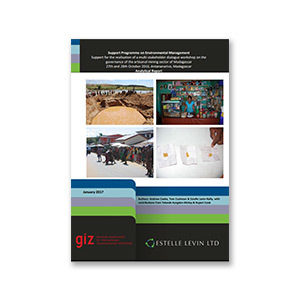Author(s): Andrew Cooke, Tom Cushman, Estelle Levin-Nally, with contributions from Dr. Yolande Kyngdon-McKay and Rupert Cook
Client(s): Deutsche Gesellschaft für Internationale Zusammenarbeit (GIZ)
Date: Jul 2017
Since 2015, several dialogue series intended to achieve better governance of the artisanal and small-scale mining (ASM) sector in Madagascar have been initiated by GIZ’s Program for the Support of the Management of the Environment (PAGE), with funding from the Australian Department for Foreign Affairs and Commerce, and in collaboration with the Ministry of Mines and Petrol. These dialogues bring the public sector, the private sector, and civil society round the table together, facilitating a better understanding of the realities at the local level, whilst reinforcing synergies and exchange between the different stakeholders.
ELL Senior Manager, Andrew Cooke, participated in a multi-stakeholder dialogue on the 27th and 28th October 2016 in Antananarivo, Madagascar. His presentation during the workshop clarified the approaches to responsible production and sustainable development in the artisanal mining sector, helping stakeholders place the Madagascan ASM sector in the spectrum between illicit ASM and fully responsible, certified production. The report summarises the presentation and provides recommendations for the responsible production of precious stones and gold in Madagascar.
Included in the approach is the ASM Resilience Pathway, available here. The ASM Resilience Pathway allows actors to determine where a country or community is on its journey towards becoming a system that enables sustainable business. Principal contributing factors include legal and policy environment, human rights protections, level of formalisation of sector businesses, quality of risk management and so on. Once the geographic area is mapped, guidance is given to ascertain what types of interventions would be most appropriate to help pull the sector towards a state where legal enterprise and sustainable development can become the norm.






